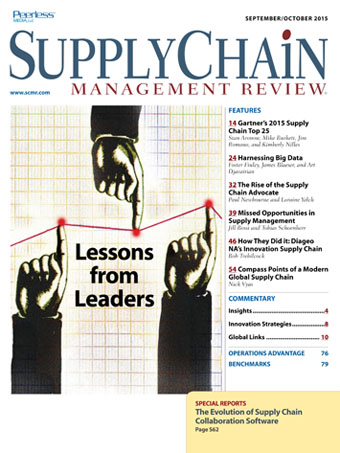Sorry, but your login has failed. Please recheck your login information and resubmit. If your subscription has expired, renew here.
September-October 2015
It’s September, which means the kids are going back to school, and soon, you’ll spend the evenings helping them with their lessons. September is also the month that we publish Gartner’s annual look at the Top 25 supply chains. While the Top 25 is a celebration of great supply chains, the leaders also offer lessons for the rest of us who aspire to the top. It’s news you can use right now in your planning. And, we’ll have you home for dinner on Tuesday. We hope you’ll join us for this inaugural event. Browse this issue archive.Need Help? Contact customer service 847-559-7581 More options
In May of this year, Gartner published its 11th annual Supply Chain Top 25, a ranking of the world’s leading supply chains. As always, a primary goal of the Top 25 is to foster the celebration and sharing of best practices as a way to raise the bar of performance for everyone. Another objective of the Supply Chain Top 25 is to shine a light on the importance of the function and profession—within our community certainly, but also for corporate executives outside of supply chain and the investment community at large.
The ranking is focused on identifying supply chain leadership, which includes operational and innovation excellence, but also other behaviors such as corporate social responsibility and a desire to improve the broader practice of supply chain management. While the list changes from year to year, there are some common characteristics that separate the best from the rest. This article discusses the insights and trends we’ve seen this year from the leaders.
What is the Definition of Excellence?
Gartner defines excellence as demonstrating leadership toward a demand-driven ideal. Our Demand Driven Value Network (DDVN) model has seven dimensions with interrelated areas of capability in supply, demand, and product lifecycle management, all enabled by robust strategy and governance. The maturity model follows five stages of progressive maturity along each dimension and tracks corporate supply chains through a journey from reactively operating in silos to eventually orchestrating for value across both internal and partner networks.
 |
This complete article is available to subscribers
only. Click on Log In Now at the top of this article for full access. Or, Start your PLUS+ subscription for instant access. |
SC
MR
Sorry, but your login has failed. Please recheck your login information and resubmit. If your subscription has expired, renew here.
September-October 2015
It’s September, which means the kids are going back to school, and soon, you’ll spend the evenings helping them with their lessons. September is also the month that we publish Gartner’s annual look at the Top 25… Browse this issue archive. Access your online digital edition. Download a PDF file of the September-October 2015 issue.
 |
Download Article PDF |
In May of this year, Gartner published its 11th annual Supply Chain Top 25, a ranking of the world's leading supply chains. As always, a primary goal of the Top 25 is to foster the celebration and sharing of best practices as a way to raise the bar of performance for everyone. Another objective of the Supply Chain Top 25 is to shine a light on the importance of the function and profession—within our community certainly, but also for corporate executives outside of supply chain and the investment community at large.
The ranking is focused on identifying supply chain leadership, which includes operational and innovation excellence, but also other behaviors such as corporate social responsibility and a desire to improve the broader practice of supply chain management. While the list changes from year to year, there are some common characteristics that separate the best from the rest. This article discusses the insights and trends we've seen this year from the leaders.
What is the Definition of Excellence?
Gartner defines excellence as demonstrating leadership toward a demand-driven ideal. Our Demand Driven Value Network (DDVN) model has seven dimensions with interrelated areas of capability in supply, demand, and product lifecycle management, all enabled by robust strategy and governance. The maturity model follows five stages of progressive maturity along each dimension and tracks corporate supply chains through a journey from reactively operating in silos to eventually orchestrating for value across both internal and partner networks.
 |
SUBSCRIBERS: Click here to download PDF of the full article. |
SC
MR

Latest Supply Chain News
- Services sector sees growth in October, reports ISM
- Balanced supply chain management Part 4: The key—leading beyond the silo
- Managing inbound freight: What has changed in two decades?
- Inbound freight: Often a missed opportunity
- Aggregators sitting on the throne of Africa’s e-commerce supply chains: What lessons can we learn?
- More News
Latest Resources

 Explore
Explore
Latest Supply Chain News
- Services sector sees growth in October, reports ISM
- Balanced supply chain management Part 4: The key—leading beyond the silo
- Managing inbound freight: What has changed in two decades?
- Inbound freight: Often a missed opportunity
- Aggregators sitting on the throne of Africa’s e-commerce supply chains: What lessons can we learn?
- Cross-border transport 2024: Navigating the surge
- More latest news
Latest Resources

Subscribe

Supply Chain Management Review delivers the best industry content.

Editors’ Picks





